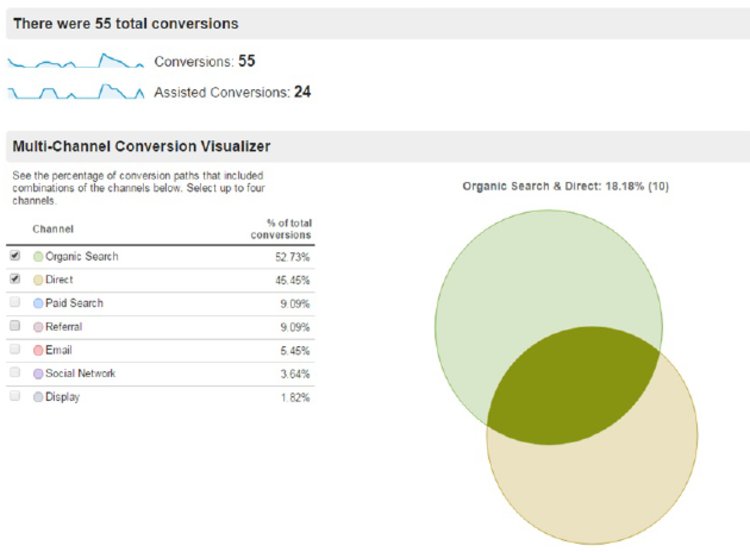
More mobile

More cross-device

More channels

More choices
But have you ever thought about how these evolving changes are impacting your marketing and lead nurturing success?
Would it surprise you to learn that competitors could be piggy-backing off your marketing efforts to swoop in and steal your warmest prospects from right under your nose?

Throughout the past few years, Google (amongst others) has been keeping a very close eye on customer behaviour.

They’ve learnt that the typical online buyer journey varies between business, sector and region. Nothing new.

But what is particularly interesting is how they differ.
Let’s take a look at a typical buyer journey for a medium sized Telecommunications business in the UK:

Marketing Funnels in UK Telecommunications
What do we see? Well, let’s start with the obvious.
A typical buyer journey in this business size, industry and region involves 5 website visits in total before purchase, including Generic paid search, Organic search, Referral or Email visit in the first three phases.
No surprises really.
But look at stage 4: Brand paid search. This example company’s warmest prospects are searching their brand name on Google.
And stage 5: Social media activity. So here’s two VERY interesting questions….(ready?)
How would the success of this customer funnel be impacted, or even collapsed completely, if one of their major competitors began:

Adwords targeting their brand search traffic?

Targeting their social media followers through organic or paid activities?
I can hear your brain ticking over. (And rightly so!)
The warmest prospects who have been carefully captured and nurtured by company A suddenly become their greatest risk of fallout. And are presented with new, enticing and exciting alternatives by company B, possibly right at the stage they’re considering a purchase.
Let’s look at another example. Here’s a typical buyer journey for a large UK business in the Food & Drink market.

Marketing Funnels in UK Food & Drink Industry
Notice how social media features much earlier this time but brand paid search features again just before a purchase.
The same question applies. How would the funnel of company A be impacted if company B starting targeting their social followers and Adwords brand searches?
You got it.
The truth is that most businesses are completely naive to the huge and concerning gaps in their marketing funnel – literally inviting competitors to swoop in and benefit from their marketing spend and efforts.
“Would it surprise you to learn that your competitors could be stealing your warmest prospects from right under your nose?”

Smart Lead generation
Now, we’re not suggesting you design your marketing strategy entirely around stealing leads from your competitors. Besides being a little unethical, I’m sure you can do better than that.
But hopefully you now understand the risks – and the opportunities – that you and everybody else in your market is facing.
So what does this mean for you?
Well, your first job is to define what your typical customer journey looks like. In terms of what channels they used, what content they viewed and who they are.
The second job is to pinpoint the areas of your funnel you could be losing leads and how to combat this.
Defining your typical customer funnel
Step 1
For an overview of the typical customer journey in your industry and region, check out this Think with Google tool.
Step 2
To see an overview of the channels your typical customers are using before purchase or enquiry, you’ll need Goals created in your Google Analytics account.
Tip. When a user completes a purchase/enquiry on your website, you should auto-direct them to a dedicated ‘success’ or ‘thank you’ URL. This way a goal can be created based on visits to that specific page (representing completion of the action, which can be tracked).
Once your Goals are created, Google Analytics will begin collating data around the Multi-Channel Funnels and Assisted Conversions. Sign in to your Google Analytics account and navigate to Conversions > Multi-Channel Funnels > Overview.
Here and within the associated Multi-Channel Funnel pages, you’ll see
- How many goal conversions you’ve had (since the goal was created)
- How many of those involved multiple channels
- What those combinations looked like
- How long they took
- How many interactions they involved
The Goals overview page should hopefully look something like this:

Pinpointing where your marketing funnel is losing leads
So now you know:
- Your typical customer journey
- The typical customer journey of other businesses in your industry
The next job is to identify stages in your funnel that could be losing leads. Keep in mind that by the time a prospect has visited your website, they’re likely to have visited at least one of your competitors also.
If that competitor, or in fact any of your competitors is doing the following, the chances are you’re losing warm leads on a regular basis and have absolutely no idea:
- Competitors are better at getting prospects to identify themselves earlier (downloads, case studies, etc)
- Have a better auto-responder email funnel
- Are targeting your brand in Adwords
- Are targeting your social audience
- Are performing remarketing
“Keep in mind that by the time a prospect has visited your website, they’re likely to have visited at least one of your competitors also.”
Identifying your prospects part-way through a marketing funnel (and greatest risk of fallout or poaching)
STEP 1: Create streams based upon full and partial marketing funnel completion.
Log in to your CANDDi dashboard and create streams based upon the funnel data attained from your google analytics, Think With Google and CANDDi visitor intelligence.
For example, if your typical & strongest customer path before purchase is generic search > email > social > brand search, then create the following streams:
- generic search > email > social > brand search
- generic search > email > social
- generic search > email
- generic search
These are your warmest prospects and also your highest risk of fallout (especially the ones performing brand Google search or Social).
Creating these streams in CANDDi is simple (and our team can even help you create them). Here is an example screen grab:

STEP 2: Know your best (and highest risk) prospects – and ACT
So now you know the specific individuals and where in the funnel they currently sit.
What now?
Well, this part is up to you and your marketing resources & preferences.
But look at this way – if you know who the prospects are you’ve carefully spent time educating & nurturing – and they are the highest risk of fall out or poaching by competitors – it makes business sense to act fast.
Either email them an offer or pass to your sales team to engage with. You are now engaging your best prospects and also increasing your chance of reducing your lead cycle.
The bottom line is if you do nothing, you risk losing them.
STEP 3: Identify ways to penetrate your competitors’ funnels
As we’ve already mentioned, Adwords brand targeting or social follower targeting is proving extremely powerful in deflecting prospects away from a competitors prospect funnels.
It goes without saying that if you’re considering targeting your competitors’ brand and warmest prospects, you have to be ready and prepared for battle. But many businesses will find they’re being penetrated by competitors in a similar way already. In which case, surely counter targeting is only a fair and reasonable form of defence.
STEP 4: Set this up, sharpish
If you haven’t done this already, you probably need to start putting it to work. If you’ve got your CANDDi dashboard set up, either create the streams or contact our team so we can help you.
If you haven’t got CANDDi yet, call us on +44 161 414 1080 today to see what it’s all about and get set up.
Make your marketing funnel watertight, take control and stop losing your best leads.
From a marketing perspective, if you have any questions around the contents or use of these tools, please email me on paul.clarke@canddi.com and I’ll be delighted to help out.
Onwards & upwards
Paul Clarke
